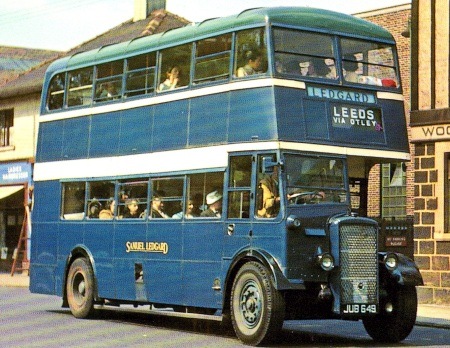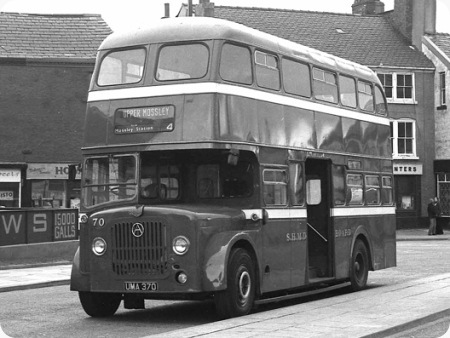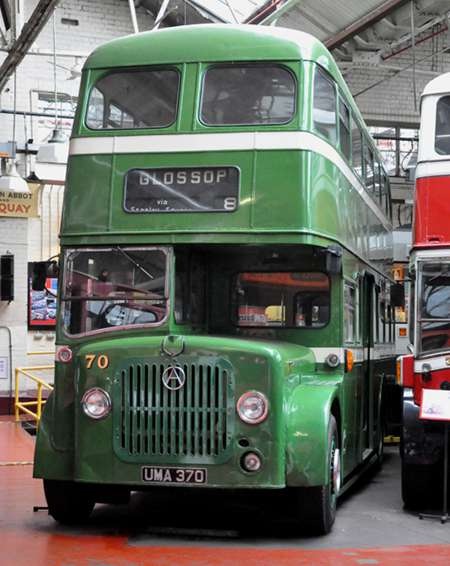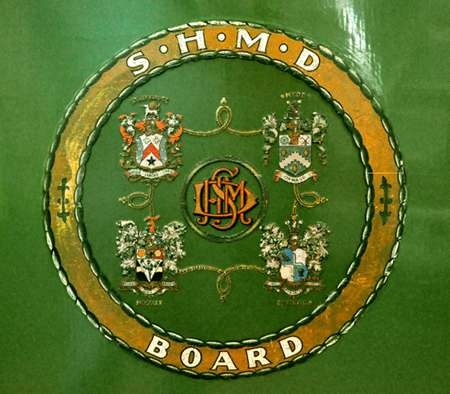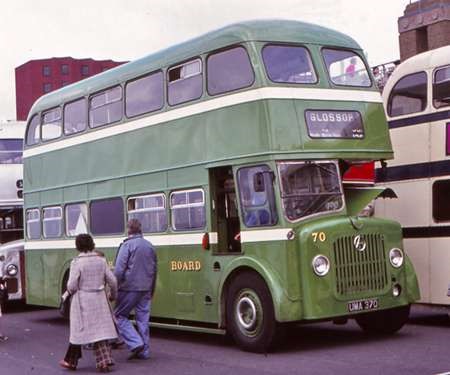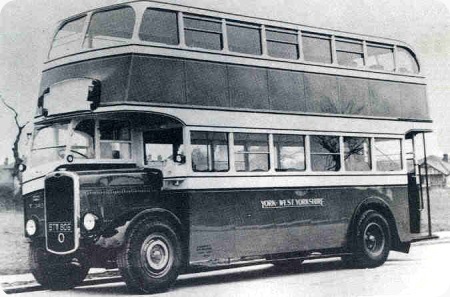Samuel Ledgard – Daimler CWA6 – HGF 948
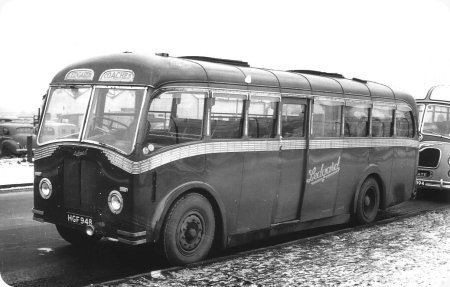
Photograph by ‘unknown’ if you took this photo please go to the copyright page.
Samuel Ledgard
1946
Daimler CWA6
Brush C36C
Life for an enthusiast working for Samuel Ledgard was always full of intriguing surprises and developments, some of which are enigmas to this very day and will almost certainly now remain so. The saga of HGF 948 is a fascinating one indeed which involves two Daimler CWA6 chassis, a prewar Maudslay SF40 coach chassis, a Park Royal "relaxed utility" double deck body, and a prewar (1935) Brush luxury coach body. The starting point of the scheme involved the first major overhaul for Ledgard’s own Daimler CWA6/Duple utility JUB 649, this routine procedure being completed in 1963 but alas, most uncharacteristically, the bodywork condition was not to the Ministry Man’s satisfaction and the vehicle was held in abeyance for later consideration. However, also in 1963, the Sutton Depot "HGF"s were being acquired and many arrived with worthwhile current Certificates of Fitness – HGF 948 was one such and the mysterious decision was taken to mount its sound body on the satisfactorily overhauled and certified chassis of JUB 649, producing a unique vehicle which could be put into service almost immediately after minor body attention and repainting. The Duple body of JUB 647, the only Ledgard utility of that make to deteriorate prematurely, was scrapped, as was the Maudslay SF40 chassis. We were now left with a Daimler CWA6 chassis with Certificate of Fitness and a prewar Brush centre entrance full front luxury coach body – "virtually impossible to match the two" you might reasonably say, but never underestimate the quiet modest expertise of those immortal Armley workshops – in no time at all the mongrel subject of this little exercise was ready to start several years of valuable service on all classes of coach duties, and was not too proud to cover the occasional conductor operated service journey when asked. Earlier I used the term "enigma" and here is one if ever there was one. Why, we wonder still, wasn’t HGF 948 left in one piece like its twenty one siblings which joined our fleet?? – and why wasn’t the Brush coach body simply mounted on Ledgard’s own Daimler JUB 649?? Here is a picture of the "new" HGF 948 at Elland Road Football Ground on a supporters’ pilgrimage – the vehicle bears a pensive expression, as if there must surely be more prestigious assignments even on a Winter Saturday !!
I’m very happy to have been able to show Chris Hebron, as requested, another of the many fascinating sides of the Ledgard operation.
This other view is of JUB 649, newly in service with the London body from HGF 948, in Otley Road, Headingley – proudly sporting its own pair of small headlamps incorporated into the original large frames from HGF 948 – only just now, while uploading this picture, have I noticed this "one off" anomaly.
Photograph and Copy contributed by Chris Youhill
A full list of Daimler codes can be seen here.
17/04/11 – 05:00
A fascinating story, Chris, all the more so because of the seeming illogicality of it all! And the headlamp modification is bizarre, the small one inside the large one. In fact, the standard LT Daimlers also had the tiny headlamps, until some of the last went for overhaul, when they were fitted with larger ones, However, HGF 948 was not one of the few overhauled in 1952, being so treated in 1949, maybe why the body was not considered entirely sound. Incidentally, I never saw an overhauled Merton one with large headlamps. Samuel Ledgard were clearly worthy successors in maintaining LT’s high standards of painting and maintenance. And it looks the ‘bees knees’ in blue, with silver-painted radiator and minus adverts! Did they all keep their LT three-piece blind displays throughout their tenure with SL? When was it finally withdrawn?
Chris Hebbron
17/04/11 – 05:10
JUB 649 brings back many fond memories as I rode on this bus on many occasions and always thought it ran smoother than its HGF London cousins. Regarding the reason for this body transfer, I wonder whether the issue was "brass." The Executors of Samuel Ledgard were struggling to keep solvent in late 1953 and having spent a lot of "brass" on the overhaul of the chassis of JUB 649, they wanted to get this bus back in service, so a quick fix would be to transfer an ex London Park Royal body with some Certificate of Fitness and HGF 948 fitted the bill. The time to sort the Brush coach body transfer on to a Daimler CWA6 chassis would take a longer time to do. Many thanks Chris for a wonderful posting.
Richard Fieldhouse
20/04/11 – 07:49
Many thanks Chris H for even more fascinating local London information about the fabulous "HGF"s. You may be amazed to hear that not one of these valiant motors retained the three piece London displays throughout their time with us. Its true to say that every single bus had the front arrangements altered many times to various differing styles – in fact if one’s memory would allow it a sizeable booklet could be written on this aspect alone – and its possible that a study of the vast number of photographs available would allow an accurate and detailed account to be assembled. Most entered service initially with the London displays masked in a variety of individual ways and often with the tiny "mean" destination blinds from prewar Titan TDs and the like. Four, however, were comprehensively overhauled from the start and were fitted with very professional platform doors and a freshly designed single front aperture, with new large size roll, and the Company name in an illuminated glass above. By contrast every one of the twenty two buses had the platform destination window fitted with paper advertisements, with a variety of advertisements for the Company’s activities. Likewise all the rear London displays were removed and impeccably panelled over. JUB 649 gave stirling front line service on extremely arduous and busy routes until withdrawal on 31st March 1960.
Richard, you are quite right in that "brass" was critically short for a couple of years after Sammy passed away – in fact its nothing short of a miracle that the Firm survived that spell to recover and eventually become smarter and finer than ever before the end loomed. We are still baffled, however, as to why HGF 948 wasn’t left alone – and the chassis of JUB 649 mated with the coach body of CUB 1 – we shall never know now shall we ??
Chris Youhill
21/04/11 – 06:08
I would imagine that transferring the coach body to the Daimler would not have been without difficulties.
I believe the Maudslay SF40 was an underfloor engine chassis with a set back front axle and would have had a straight floorline throughout and as it was centre entrance, would have had two seats beside the driver. Presumably, a hole would have been cut for engine intrusion and a bonnet would have been required to cover it and then a bulkhead added where there hadn’t been one previously.
I guess the wheelbase of the two vehicles would have differed also.
Certainly one of the most fascinating creations I’ve ever seen!
Chris Barker
21/04/11 – 11:45
A bit of confusion here Chris B I’m afraid. The Maudslay SF40 was a front engined chassis, with prominent and ugly starting handle to prove it. The transfer of the body to a Daimler CWA6 chassis was indeed a difficult – outlandish even – performance, but this was achieved by Rhodes of Bingley (a coachbuilder and repairer) who made the necessary modifications to the Brush coach body. The procedure could have been carried out in exactly the same manner though if JUB 649 had been chosen (having a chassis identical to HGF 948) and so the mystery of why the Londoner was interfered with in this interesting saga remains unanswered and I fear always will. The upside of the strange affair is a bonus though, as enthusiasts were treated to two literally unique vehicles.
Chris Youhill
21/04/11 – 11:56
Look at the relationship between the steering position/wheel and the front: we are surely looking at quite a space in front of the where the front should be: was the driver barbequed, or was the coach like one of today’s "luxury" service bus rattlecans where the driver does not seem to know how to regulate the heating?
Joe
22/04/11 – 06:44
Chris Y, yes of course the SF40 had a front engine, the number of times I’ve looked at pictures and seen the starting handle as you say, and the large grille but its one of those rarities which gives a false sort of impression, I think its because the entrance was (usually) ahead of the front wheel!
With regard to Joe’s comment, I hadn’t noticed the steering wheel does seem quite a way back from the windscreen, would the conversion have involved alteration of the driving position?
Chris Barker
22/04/11 – 11:44
Joe and Chris B have raised an amazing issue which I had never noticed before – shame on me as one of the most avid of Ledgard devotees !! Firstly, I’m quite confident that no alteration whatever was made to the Daimler chassis of HGF 948. This being the case, comparison of the Brush body in Maudslay and Daimler days reveals some far more dramatic coachwork alterations than I’d ever noticed.
On the Maudslay the front axle occupied the first two bays ahead of the centre exit, but not the front section – on the Daimler the bay ahead of the exit has become uninterrupted while the CWA6 front axle occupies most of the front section. Whether or not the length of the front/windscreen section has been slightly increased is debatable – possibly it has a little, and this would account for the quite unusually large distance between the driver and the windscreens. It seems likely that the Daimler chassis members have been lengthened slightly, possibly to allow the radiator to be mounted immediately behind the front panels, explaining why the driver is so far back. One thing I’m sure about – if Sir Edward Elgar had been around he would certainly have written an extra "Enigma variation" in honour of this fascinating vehicle, and I wonder what the Sutton commuters would have thought if they could have seen the unique career which awaited their motive power in its later years !!
Chris Youhill
23/04/11 – 08:13
It seems to me that the front end of the chassis was left unaltered and I would expect to find the original Daimler fluted radiator under there, with all that was used of the SF40 chassis front end being the grille. What has happened is that the body overhangs the front of the chassis after modification, giving the effect that the steering wheel has been set back. To change the geometry of the steering would be a very complex job and easy to get wrong.
I need to swot up on my maximum legal vehicle lengths. Although the chassis proportions have been altered, there is no issue with overall length as single-deckers had a longer maximum permitted length than double-deckers and by the time this had been modified thirty foot long single-deckers were legal.
David Beilby
23/04/11 – 08:14
As you’ve already alluded to, what a lot of effort to go to, especially as the body alterations were out-sourced! I’d love to have ridden on this mongrel, or maybe hybrid would be a better word!
Chris Hebbron
23/04/11 – 08:15
The camera angle can be deceptive, but if you look at JUB you can see the difference: the driver is no longer sitting "on" the front axle. This is not, I think, unusual in a coach of that vintage. My idea was that you had a hot Daimler engine, reeking of diesel cooped up in the passenger "saloon" but of course it’s not, it’s an AEC! Yes- it looks as if the radiator could have been brought forward to the front of the (extended) chassis.
Who, by the way, installed that "Bentley" radiator grille on JUB?!
Joe
23/04/11 – 08:16
Clearly Ledgards could have selected a doner vehicle for the coach which would have made for a much simpler conversion – and a newer one too, the decision to rehabilitate a seventeen year old coach body was astonishing to say the least but perhaps the Maudslay was chosen because they wanted the end product to have a full front.
As for HGF 948, if as you say Chris Y, the body was sound and it had a current Certificate of Fitness, this is pure speculation but is it possible the CofF would have expired in a relatively short time and the need for serviceable deckers was desperate? The coach appears to have been fitted with a half bulkhead behind the driver, just up to waist level, is there a photo of the Maudslay before the conversion?
It occurred to me how wonderful it is that Ledgards unwittingly provided two creations which are a source of interest and fascination to us nearly sixty years later, something which will never happen in future!
Chris Barker
23/04/11 – 16:39
I’m surprised at how much interest this matter has aroused, and so many theories also. So here is a photo of the Maudslay CUB 1 when new (source unknown but presumably Brush Works). Also the original posting shot is with it for comparison.
Chris Youhill
24/04/11 – 07:21
Thought for the day. Why did AEC buy Maudsley and Crossley in 1948? They were both lame ducks and financial disasters. [Yes, I know, they were also innovative engineers but they never followed through with practical or commercial successes.] What was in it for AEC? They derived far more benefit from Park Royal – Roe a year later in 1949.
David Oldfield
24/04/11 – 07:25
Thx for the ‘before’ photo, Chris Y. I have to say that the original product looked better and surprisingly modern for 1935. It would have passed muster as new in 1948, IMHO. The starting handle slightly mars the sleek effect, though! Interesting that the quarter bumpers survived the rebuild!
Chris Hebbron
25/04/11 – 06:52
Yes thanks indeed, even more interest! The rebuild appears to be even more substantial than I imagined.
Just like those ‘spot the difference’ competitions, I notice that the outward flare of the skirt panels was removed, BOTH wheelarches were re-positioned and altered, the nearside front window appears to be the same length but droops more at the corner and the front dome seems to be different also, all this and the considerable alteration to mouldings, amazing!
Chris Barker
25/04/11 – 13:18
As you say Chris B, this saga gets ever more fascinating. While I was aware that the outward flare of the skirt had disappeared I hadn’t noticed until you pointed it out that the Daimler rear axle caused the rear half of the body to be "adjusted forward" by about one bay width. Without detracting from the many fascinating operations embarked upon by my grand old Firm it has to be said that the scope of this particular scheme becomes ever more astonishing, and no doubt expensive ?? – for a result which went directly against the "modern look" craze which was all the rage at the time.
Chris Youhill
25/04/11 – 17:57
I can guess at the Maudslay/Crossley takeover- AEC wanted more capacity for anticipated post war orders which could not be provided in austerity Britain- so buy it in and use the best of the resources you have acquired, plus factory capacity.
As for the "new" coach, do you think the coachbuilders wanted some practice, again with a view to post war expansion & had no chassis to work on? It’s the sort of job you set the apprentices on!
Joe
27/04/11 – 07:41
One further comment then I’ll cease! The original vehicle (the Maudslay) was a very handsome coach of which Ledgards were no doubt justifiably proud. It achieved a very creditable sixteen or seventeen years service (including a world war!) and as Chris H says, it would have stood up well against many an early underfloor engined coach of the early fifties.
I hadn’t realised that there is a photo of it in the ‘Prestige’ volume, which tells us that it was fitted with a Leyland 8.6 litre diesel unit in 1948. Presumably, by 1952, the Maudslay chassis was beyond redemption mechanically, especially as that company had sold out by then. It made me wonder if it would have been a cheaper option to transfer the Daimler running units into the Maudslay chassis but I know little about such matters.
Perhaps Ledgards went into the venture thinking that the fine looks of the original would be retained but as we see, the rebuild, whilst being something to marvel at, rather lost the gracefulness of CUB 1.
Chris Barker
28/04/11 – 06:34
Please Chris B , no need to cease commenting at all!! I had completely forgotten about CUB 1 having its Maudslay engine replaced by an 8.6 litre Leyland unit and, while there’s a year or so discrepancy in various accounts, I imagine that it would be the engine removed from 1936 TS7 Tiger/English Electric CUG 844 which was prematurely and very surprisingly withdrawn with a cracked chassis.
Chris Youhill
29/04/11 – 06:55
Well ok! No doubt the Maudslay engine was life-expired by 1948 but could it have been that after fitting the Leyland 8.6 unit, problems arose with massive engine overhanging the front axle? (does that remind you of anything?) There was something I just couldn’t put my finger on when looking at the two pictures, then I realised. Erase the grille and starting handle from CUB 1 for a moment and like I said, it could easily be taken for an underfloor engined coach of the early fifties. In its second incarnation, it was very obviously a front engined vehicle with full front.
Chris Barker
30/04/11 – 06:53
Bearing in mind that this was a bus built as a decker, as a coach, it must have had quite a lively performance.
Chris Hebbron
30/04/11 – 06:55
Yes Chris B, I daresay the Leyland engine was much heavier and, although I never heard of any difficulty arising from that, its quite feasible that it was a problem. I chuckled when you asked if that reminded me of anything – only a few weeks ago I was privileged to be allowed to sit in the cab of the preserved West Riding Guy Wulfrunian, and even though it was safely in a depot shed with the engine off, I almost reached for the travel sickness tablets on remembering that four way swaying and hissing of air valves from all those years ago !! As is widely known the excess weight on the front was ultimately partly relieved by removing eight upper saloon seats – that’s the end of this diversion from the topic.
Chris Youhill
30/04/11 – 15:27
Amazing, Chris Y. I suggest that someone posts a photo of a Guy Wulfrunian, which would probably generate a record number of posts! I believe it would just qualify on age grounds!
Chris Hebbron
 Vehicle reminder shot for this posting
Vehicle reminder shot for this posting
20/01/17 – 14:13
I was wondering if anyone knew why some of the fleet had green roofs?
Jeff Lawton
21/01/17 – 07:25
No problem at all there Jeff – the saga of the green roofs is a delightful one. When Mr. Ledgard’s first double deckers arrived in 1930, all Leyland petrol Titan TD1s, they had wooden roofs covered in green canvas. This appealed to Samuel who immediatlely decreed that all future double deckers would have green roofs and indeed they did, right up to the 1957 AEC Regent Vs with Roe bodies. Also possibly for a short while after that second hand vehicles did so as well – ex Bury Daimler/Roe EN 8408 was certainly one.
Chris Youhill
